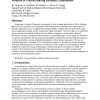Free Online Productivity Tools
i2Speak
i2Symbol
i2OCR
iTex2Img
iWeb2Print
iWeb2Shot
i2Type
iPdf2Split
iPdf2Merge
i2Bopomofo
i2Arabic
i2Style
i2Image
i2PDF
iLatex2Rtf
Sci2ools
JSS
2006
2006
Patterns of conflict among software components
Integrating a system of disparate components to form a single application is still a daunting, high risk task, especially for components with heterogeneous communication expectations. It benefits integration to know explicitly the interoperability conflicts that can arise based on the current application design and the components being considered. However, there is no consistent representation of identified conflicts that also defines strategies to resolve them. Instead, developers use prior experience which may have consequential gaps. In this paper, we formulate a common representation for six major interoperability conflicts that arise through discrepancies or direct mismatches among architectural properties of interacting components. We use an Extender-Translator-Controller (ETC) classification scheme to describe the conflict resolution strategies. Detailing these associations as patterns provides insight into formulating an overall integration architecture design reflecting the s...
Disparate Components | Heterogeneous Communication Expectations | JSS 2006 | Major Interoperability Conflicts |
| Added | 13 Dec 2010 |
| Updated | 13 Dec 2010 |
| Type | Journal |
| Year | 2006 |
| Where | JSS |
| Authors | Michelle Hepner, Rose F. Gamble, Manasi Kelkar, Leigh A. Davis, Daniel Flagg |
Comments (0)

